Just for a bit of fun this time; before I offer my assessment of this oak and yew chest-on-stand, would anyone else care to interpret the images and propose a date?
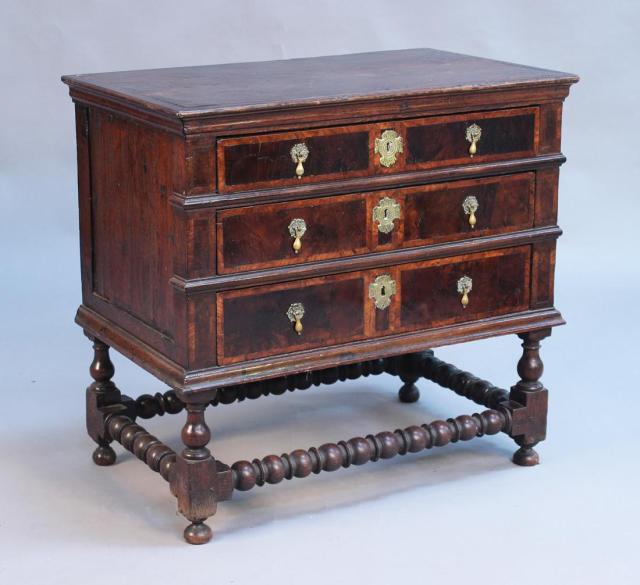 Fig. 1. Oak and yew chest-on-stand. (Tooveys)
Fig. 1. Oak and yew chest-on-stand. (Tooveys)
Update, November 5th.
The tell tale damage on the back right stile and bottom rail (fig. 5) was caused by rats sharpening their teeth on the hard oak arrises. This could only have occurred with said components close to the floor where rats habitually run along the perimeters of walls. This chest did not originate on a stand. I believe the chest began life circa 1670-80 as a fairly standard joined, four-drawer oak chest (fig. 6).
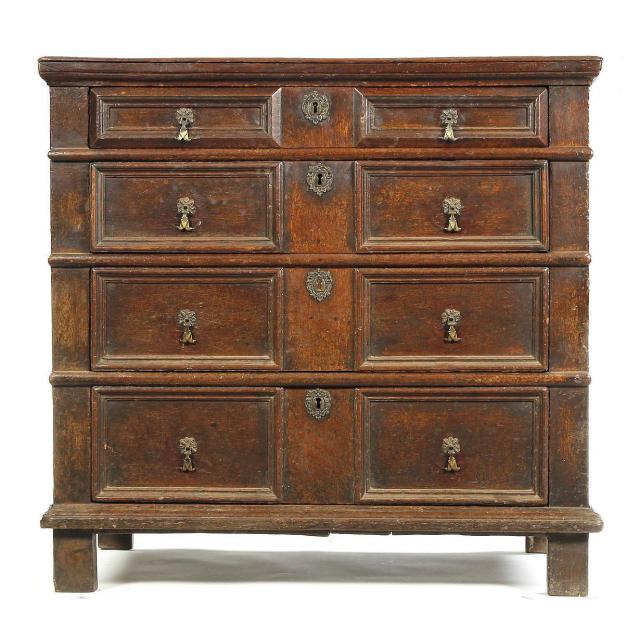 Fig.6. Charles II oak chest, circa 1670. (Bonham’s)
Fig.6. Charles II oak chest, circa 1670. (Bonham’s)
Traditionally, valuable cutlery and silver flatware was kept either in decorative boxes on the sideboard, in the dining room, or in the butler’s pantry, under lock and key. However, during the first half of the twentieth-century, canteens in the guise of antique furniture were all the rage, especially when they matched the contemporary Chuckabethan revival furniture (fig. 7).
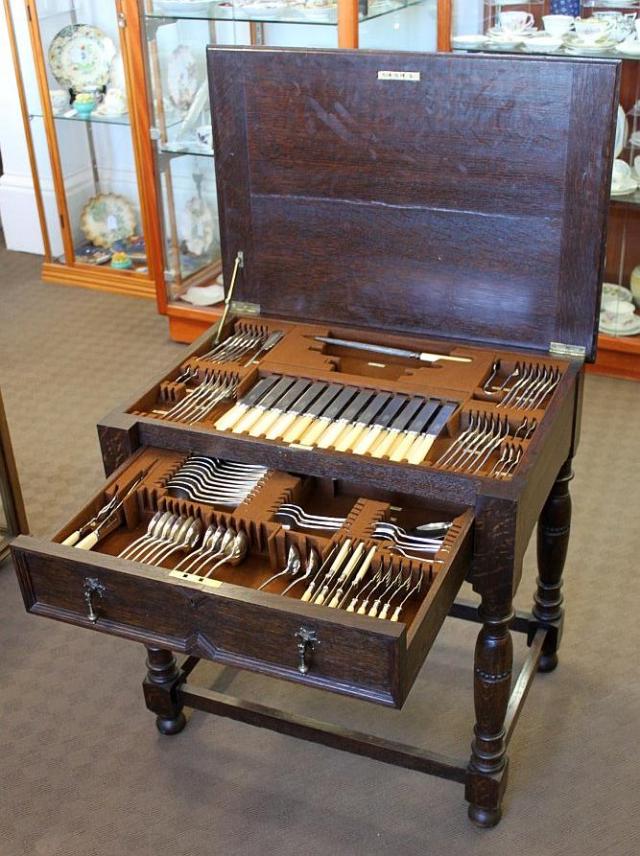 Fig. 7. Mappin & Webb oak Chuckabethan canteen, circa 1915-20. (China Rose Antiques)
Fig. 7. Mappin & Webb oak Chuckabethan canteen, circa 1915-20. (China Rose Antiques)
The dealer or restorer who perpetrated this abomination utilised a (likely poor and decrepit) Charles II oak four-drawer chest. I imagine the mouldings were popped off and the pegs (the sole means of joining the carcase together) were either drifted or drilled out, reducing the carcase to a pile of parts. The bottoms of the four stiles were shortened and new mortises chopped out to house the bottom rails, thereby reducing the chest to a three-drawer chest.
The valuable (likely one-piece) wainscot side panels would have been saved for a future project and were replaced with a number of narrow second-hand quartersawn oak boards (note the black stains from contact with iron nails or hooks etc.).
The plain boarded top would have been planed flat and then veneered with yew. The carcase would then have been reassembled with new pegs and the top and bottom mouldings nailed back on.
The applied mouldings (or what remained of them) on the drawer fronts would have been cleared off and the drawer fronts veneered in yew and then crossbanded.
On the rare occasions one comes across a Charles II chest with integral stand, the chest’s stiles also form the legs of the stand (fig 8).
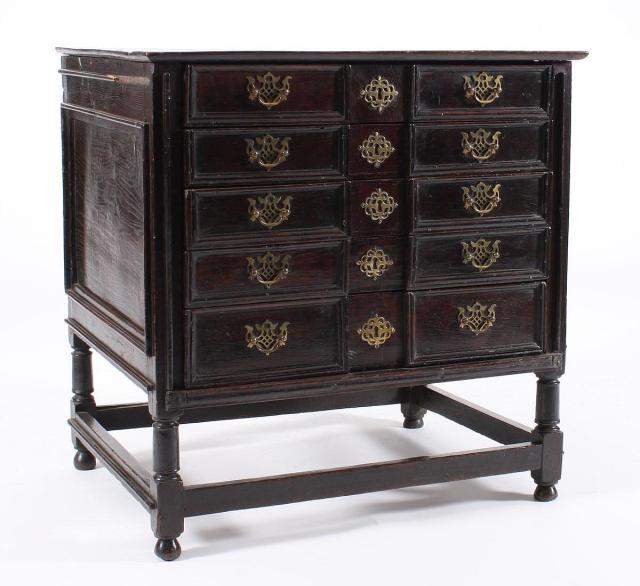 Fig. 8. Charles II oak chest with integral stand, circa 1660 (later handles). (Bonham’s)
Fig. 8. Charles II oak chest with integral stand, circa 1660 (later handles). (Bonham’s)
The attachment point of our chest to its alien stand can be clearly seen at the bottom of the back left stile, level with the bottom edge of the bottom rail (fig. 5).
Legs and stretchers turned with ball-and-reel, ball-and-ring or egg-and-reel decoration were fashionable on chairs, chests, settees and tables during the late seventeenth-century (fig. 9), but given the dimensions of the chest and the height of the legs, the ball-and-ring-turned stand undoubtedly began life as the undercarriage of a dilapidated late seventeenth-century oak settee.
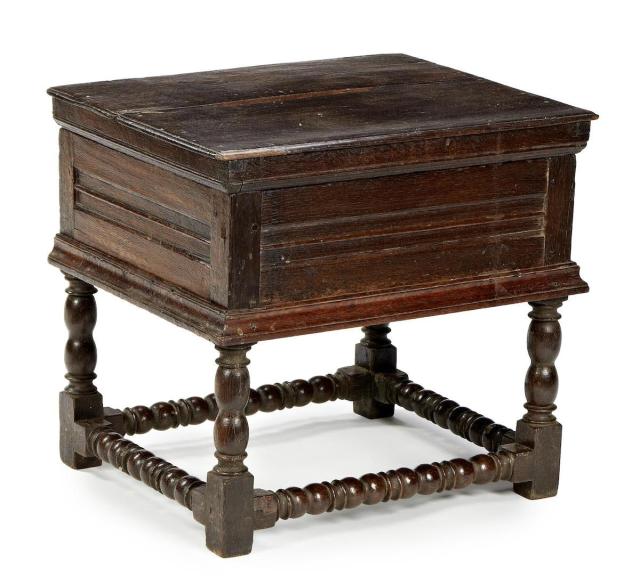 Fig. 9. Charles II oak close stool with ball-and-reel stretchers, circa 1680. (Bonham’s)
Fig. 9. Charles II oak close stool with ball-and-reel stretchers, circa 1680. (Bonham’s)
We know the settee was dilapidated, because it had lost its turned feet as can be witnessed by the wear and wet-mop bleaching to the legs’ square blocks on which they must have stood for some decades (fig. 1). The legs presumably regained their turned feet during the conversion process.
Lastly, one or more drawers were fitted with partitions and lined with baize to accommodate cutlery and flatware.
Thanks to all the sleuths who joined in and offered opinions; it was most enjoyable.
Jack Plane

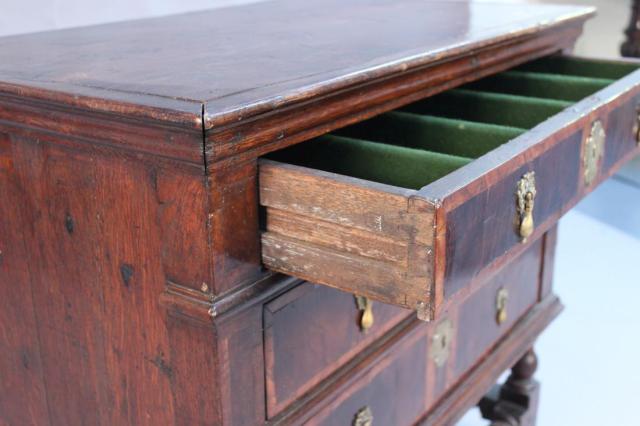
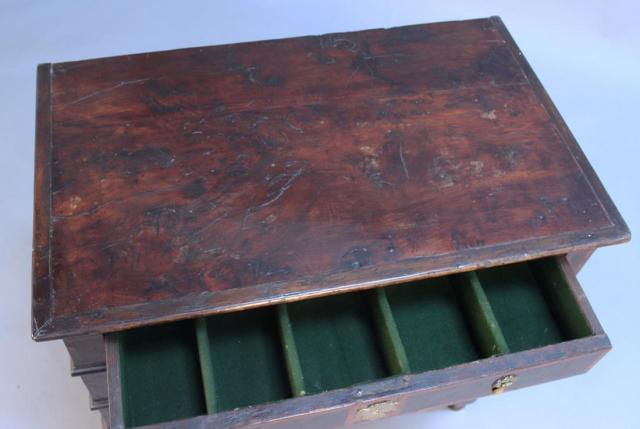
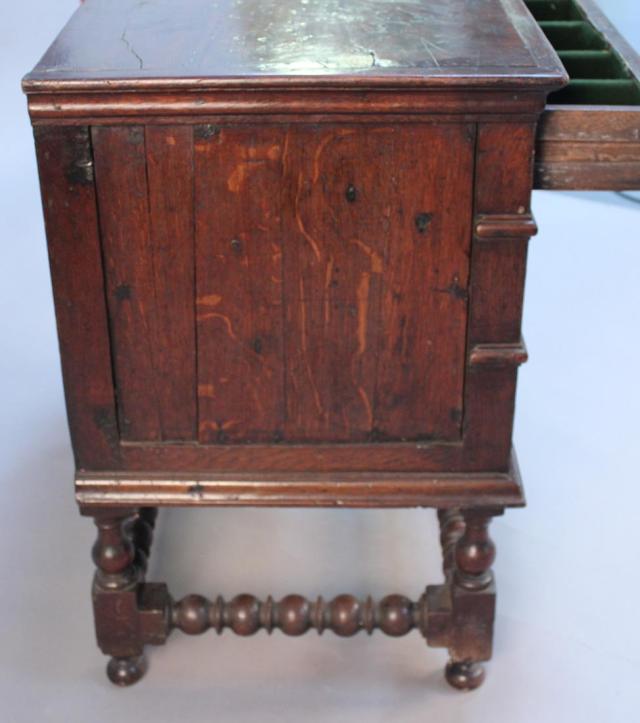
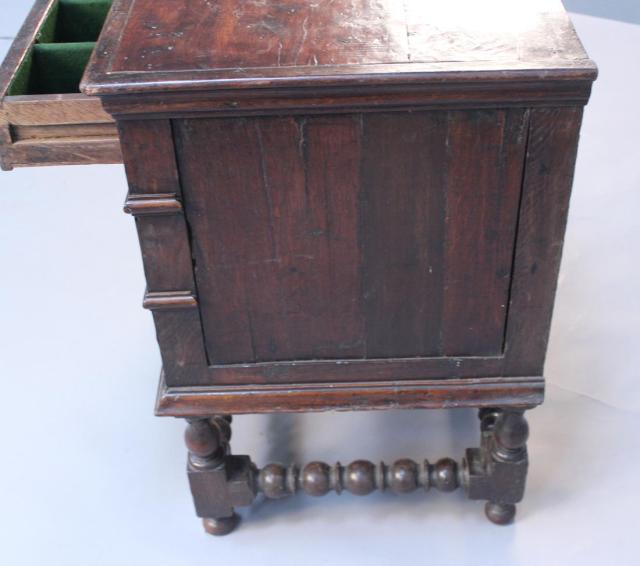
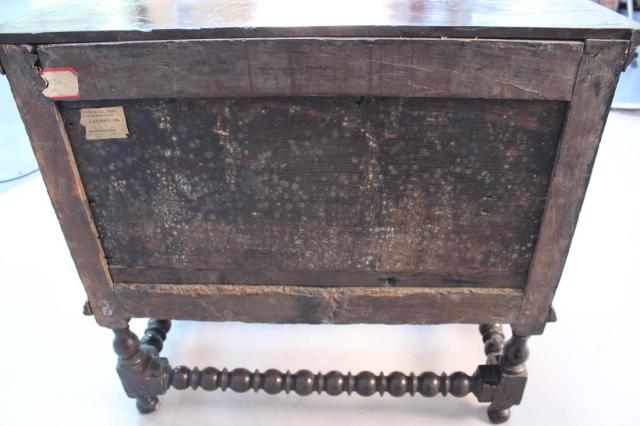
1670 or so, joined, later stand, Poss top half of chest on chest/cupboard. Love the back panel
LikeLike
I’ll guess that it’s Charles II, and somebody updated it seventy years later by replacing some of the applied mouldings on the drawers fronts and carcass front edges with veneer.
Please be gentle.
LikeLike
Charles II is right (what about a date?). Your dating of the crossbanding is somewhat out though. I need much more, and with reasoning.
There’s a good clue in figure 5.
JP
LikeLike
Was it was originally a mid 17th century five drawer chest, then someone took it apart to turn the bottoms of the posts? I’m wondering because nearly all the chests on stands I’ve googled show the stands as an entirely separate construction. If I had to say anything about the crossbanding, I’d revise my guess wildly and say 1820s, just because it matches the colour scheme of the few mahogany Regency style chests I’ve seen.
LikeLike
Oh… more drawers you say?
It’s basically a circa 1670-80 chest. The crossbanding is probably trying to be ten to twenty-five years later.
JP
LikeLike
I look forward to your exciting revelation re. this piece.
LikeLike
The escutcheons are oversized so they are later upgrades by my reckoning; ergo, the chest is one generation older than the brass fittings. The green cloth looks like something Pepys would have liked so I estimate circa 1640.
LikeLike
Oh I’m liking this!
LikeLike
I’m far, far from any expert but it does look to be a marriage of many eras, Could this be put together from many period parts/pieces? Top chest to “heavy” for the base/legs, they look to be shortened or the bottom portions cut off, the side construction does not mate with the drawer construction. and don’t get me started on the moldings. To me just an odd grouping of period parts..and a little awkwardly done too…..Just saying…(Boy will I eat crow if I’m wrong)
LikeLike
Keep it coming!
LikeLike
Drops appear Willy-Mary, crossbanding too.. Charles II – 1660s (1640 being a bit early for Chuckie) with later bling.
Rather odd backboard, was it a converted chest/box? The stand is solid, staid and clunky, I’d put a sofa (well, half one) on it.
Fire away!
LikeLike
Too early, but the drops are certainly of W & M style.
I’ll accede the backboard(s) are inconsistent, but that’s not the crucial clue in figure 5.
Why a sofa?
JP
LikeLike
The base is extremely similar to those of sofas in Percy Macquoid’s, A History of English Furniture vol.2, 1938, p72, or Adam Bowett’s Early English Furniture 1660-1714, p72.
Figure 5. – Very odd wear to the lower rail etc.for the back of a chest, and quite long side rails too…
Cheers,
Burbidge..
LikeLike
Right! That’s the origin of the base covered, though, as touched on in a comment below, not the entire story.
Don’t think of the damage at the back of the carcase as wear: what else can cause that pattern of damage?
JP
LikeLike
Rot.
LikeLike
Not in this case… unless that’s a typo.
JP
LikeLike
Rats or chickens!
LikeLike
Chickens? Where do rats normally run along indoors?
JP
LikeLike
Could this be one of those victorian “frankenstein” pieces? late 19th century?
( I might be digging my self deeper in the “boy am I wrong” pit))
LikeLike
You’ve got a good spade.
JP
LikeLike
RE figure 5,…. back panel seems to be not proper…nail holes along left edge and top edge…also two on right but further from the edge….shows it is a reused panel…plus dovetail on top of left leg post but not on right???Repaired section on lower part of panel…seems not to match the wear pattern of the lower rail? I’m digging!
LikeLike
I don’t see a dovetail, though you’ve hit a feint vein of gold. Keep digging.
JP
LikeLike
In figure 1, what’s odd about the front left leg.
In figures 2 & 3, what are the drawer divisions for?
In figure 5, what’s different about the back right stile and bottom rail?
JP
LikeLike
Fig 1, shows damage/wear on square section but not on the “ball” or foot. It would make sense that the ball would have the same type of issue.
Fig 5, the dovetail shape on top of one side stile but not the other, although both show pins to hold the top rail??? why the end of a dovetail from an interior rail on only one side???? The bottom rail and one stile show similar wear but not on the other stile
Fig 2$3. The divisions are for the cash that the dealer gets for selling these types of make-ups.
Also in fig 1, Top of case…different wood/color than front molding?? and shows possibly attached with nails…four on left side 3-4 on front, maybe three on right????…(yea..now I’m digging, it’s dark down here it’s getting hard to see)
LikeLike
The front left foot does indeed show wear from being in contact with the floor and bleaching from frequent wet mopping. Is the age of the stand commensurate with the chest?
I think what you see as a dovetail, I see as a disintegrating knot.
What caused the “wear” to the back right stile and bottom rail, and how?
Were three drawer chests (with drawers of this height) common in the late seventeenth-century? The drawer divisions and baize lining look like canteen divisions to me. If so, where would that likely date (at least some of) the alterations to? Could there be any relation here?
The top and drawer fronts are veneered in yew and the mouldings are of oak.
What about the side panels?
JP
LikeLike
side panels seem not to be in grooves. show black stain/marks as if nails were used, fig 4 shows odd damage/breaks along one of the front panels but not on the front stile. re-used parts again?
LikeLike
Yes, I don’t believe the side panels are original to the carcase.
Keep the critique up and I’ll divulge what I can discern tomorrow.
JP
LikeLike
Is there a clue or is it just stylistic that the back turning is worked to the same degree as the front and yet the sides show a marked degree of labor reduction in their appearance?
LikeLike
I don’t believe so.
JP
LikeLike
This chest doesn’t really float my boat, but looking at the overall proportion of the chest it looks to be the top half of a 2 part chest. The wide cornice-type moulding, if original, on the top would suit a taller chest, and the way the top sits inside the top moulding could mean it was a later addition or not intended to be seen? Likewise the smaller moulding on the bottom would suit sitting on a more substantial base. The 3 drawers would also be explained by being the top half of a larger piece?
Would 17th C side panels normally be made of fewer but wider boards?
The stand looks too small for the chest, and would seem to be an awkward mixed marriage. Maybe this is the result of multiple repairs and updates over the ages? Maybe some estate carpenter has made something serviceable from other damaged pieces?
I don’t know why the top drawer has dividers like that, its almost like a cutlery drawer.
Looking forward to your explanations
Cheers
LikeLike
Getting picky but…there are slight saw cuts on the top panel in fig5 just above the joint between the leg post and the rail, why? only Jack knows, I still think the top panel is nailed onto a frame or something….Wish we could read the labels…..
LikeLike
I like this game and hopefully you can play again!!!
I’m going to say William and Mary and based on the giant dovetails I’ll date this to the 17th century. I’ll place a date of 1680-1690
LikeLike
Our rabbit hutch shows wear like that on the bottom rail and the styles.
LikeLike
Wear, or are the rabbits gnawing on the arrises?
JP
LikeLike
They gnaw like crazy! So has this little chest a history of housing rabbits?
LikeLike
Not rabbits within, but rodents without!
How would rats have reached the arrises of the stile and rail to gnaw on them?
JP
LikeLike
Ok I’m going to finalize my opinion…The only Furniture parts are the drawers (1670-90) and possibly the leg posts and stretchers…all other parts are from later broken chests, crates, wainscoting etc. Parts found in barns, basements, attics. All assembled during the late 19th century and made to look authentic with period brasses. Too much of a mix to be just an updating or alteration of an original piece……bury me now, I’m deep enough!
LikeLike
Fig.3 – is there a hinge bracket on back rail near the top?
Fig.5 – back frame draw bored joinery?
Fascinating piece…!
LikeLike
No hinge.
Yes, the whole chest is draw-bored.
JP
LikeLike
Hi, I considered rodents but wasn’t confident to mention it for a couple of reasons. Partly because the photo was too low res to identify the very characteristic gnaw marks. Also, rodents are very efficient little creatures and typically localise their gnawing of inedible materials to form just a hole or two to get in. This would explain why the bottom of the back panel has been replaced, but why do you reckon they would chew all along the left stile and bottom rail in this case? They would also need a reason to spend the energy getting in. Would there have been food inside the bottom draw? Does this tie in with the cutlery caddy drawer? Perhaps just a warm place to nest?
Cheers. I am really enjoying this interesting discussion.
LikeLike
All great detective work!
I have updated the post above with my conclusion.
JP
LikeLike
Please do this again at some point.
Any chance you might offer a ten book shortlist from your library? I’m in rural area of Canada, so shopping for books will have to be online and I’d rather not rely entirely on Amazon reviews.
LikeLike
I will gladly repeat the exercise if another hashed piece of furniture crops up.
I’ve listed ten furniture titles in alphabetical order of authors. None are to be treated as gospel; academics have a habit of getting it wrong as we saw recently on the matter of the pair of Gothic Windsor chairs in Picture This LXII, and a second author from my list got it well and truly wrong in A Small Queen Anne Gateleg Table – Part Four. The incidents are not isolated; however, if you take the gist of the material, it should set you on a good course.
BOWETT, Adam, Early Georgian Furniture 1715-1740, Antique Collectors’ Club, 2009.
BOWETT, Adam, English Furniture from Charles II to Queen Anne, Antique Collectors’ Club, 1999.
COTTON, Bernard D., The English Regional Chair, Antique Collectors’ Club, 1999.
CRISPIN, Thomas, The English Windsor Chair, Alan Sutton Publishing, Stroud, 1992.
EDWARDS, Dr. Clive, et al, British Furniture: 1600-2000, The Intelligent Layman Publishers Ltd., 2006.
GILBERT, Christopher, English Vernacular Furniture, 1750-1900, Yale University Press, 1991.
GLIN, The Knight of, and PEILL, James, Irish Furniture, Yale University Press, 2007.
KNELL, David, English Country Furniture: 1500-1900, Antique Collectors Club, 2000.
McQUOID, Percy, A History of English Furniture Including The Age of Oak, The Age of Walnut, The Age of Mahogany, The Age of Satinwood, Bracken Books, 1988.
SNODIN, Michael and STYLES, John, Georgian Britain 1714-1837 (V&A’s Design & the Decorative Arts, Britain 1500-1900), V & A Publications, 2004.
JP
LikeLike
Thank you! I owe you.
REALLY looking forward to you own book. Let it be known when/if pre-ordering is possible.
LikeLike
“I owe you.”
Got any walnut?
JP
LikeLike
Excellent thread gentlemen! Yes – definitely do this again.
LikeLike
Yes, Thank you For this challenging post. I can now crawl out of the hole after two long sleepless nights….Very enjoyable…We all look forward to the next challenge!
LikeLike
Regarding Fig 5 with the rats gnawing on the bottom rail. Was it common for chests to lie flat on the floor without legs in the 17 century? If so, did this extend very far into the 18th century?
LikeLike
On the contrary; chests were raised off the floor on feet as in figure 6, but the arris on the back bottom rail would still have been easily within reach of a rat on its hind legs.
JP
LikeLike
well, Mark Firley is back in the country and Ill bet he has a couple of pictures just about like it.
LikeLike
Jack, on your list of books, McQuoid’s “The History of English Furniture” has been printed in many forms and by many publishers over the years. Is the 1988 version (all 4 volumes in one book) recommended or should the earlier separate four volumes be sought out? Do you know if there any difference between the old and new that matters? The originals were printed 1905 and the reprints vary (hardcover, softcover) till the single volume in 1988 as far as I can find.
LikeLike
The single volume of A History of English Furniture is all you need.
JP
LikeLike
Pingback: Picture This LXVI | Pegs and 'Tails